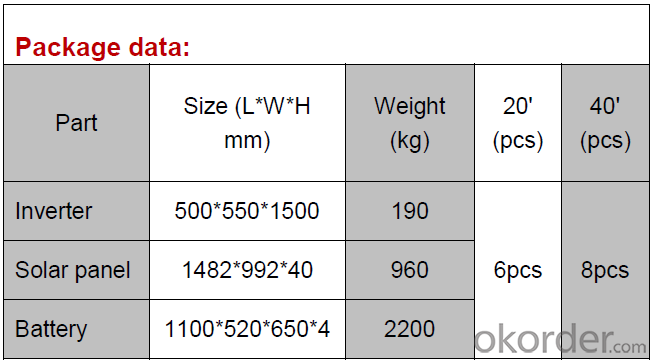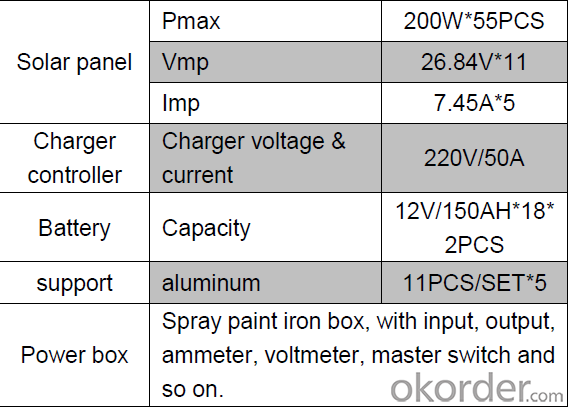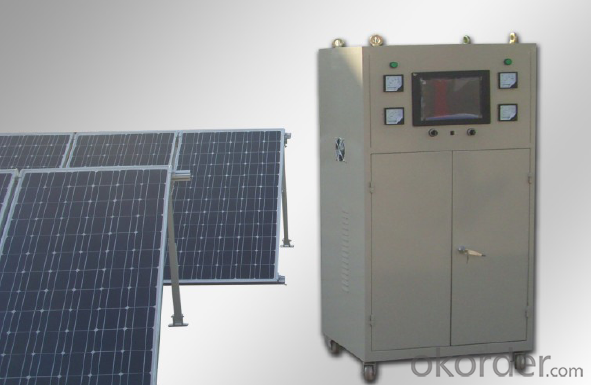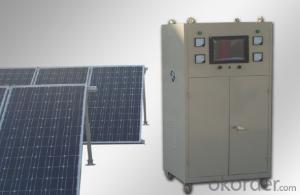Solar Home System CNBM-K8 5KW from CNBM
- Loading Port:
- China main port
- Payment Terms:
- TT OR LC
- Min Order Qty:
- 1 watt
- Supply Capability:
- 100000000 watt/month
OKorder Service Pledge
OKorder Financial Service
You Might Also Like
Item specifice
Description:
CNBM Solar is a world-leading and Vertical integrated manufacturer ofhigh-performance with Silicon,
Wafer, Cells, Modules, which convertsunlight into electricity for residential, commercial, and utility-scale
power generation.
The capacity of CNBMSolar is reach to 1GW, andmake sure each year our shipment capacity is more
Than 700-800MWs, at the same time, wehave set up the largest solar power station with our partner
in Ukraine.
CNBM is a Quality + Service orientedcompany with“Excellence at Each Step” approach, composed of
the finest components from TUV andIEC-certified partners around the world, CNBM modules consistently
undergo a variety of trials at thecompany’s Test & Development Centre, ensuring peak performance
capabilities. The company iscommitted to develop and provide the world with clean and renewable energy
to ease the energy shortages as wellas human kind’s impact on the environment.
Data:




FAQ:How long can we receive the product after purchase?
In the purchase of product within three working days, We will arrange the factory delivery as soon as possible. The pecific time of receiving is related to the state and position of customers.Commonly 7 to 10 working days can be served.
- Q:What is the lifespan of solar inverters?
- The lifespan of solar inverters can vary depending on various factors such as the quality of the inverter, its usage, and maintenance. On average, a solar inverter can last between 10 to 20 years. However, regular maintenance and timely repairs can help extend its lifespan.
- Q:What is the impact of roof orientation on the performance of solar panels?
- The impact of roof orientation on the performance of solar panels is significant and can greatly affect their overall efficiency and energy generation. The orientation of the roof refers to the direction in which it faces, whether it is towards the south, east, west, or north. Ideally, solar panels perform best when they are installed on a roof that faces south, as it allows them to receive the maximum amount of sunlight throughout the day. South-facing roofs receive direct sunlight for the longest duration, which means the solar panels can capture more solar energy. If the roof faces east or west, the solar panels will still receive sunlight, but their energy generation may be reduced. East-facing roofs receive morning sunlight, which is beneficial in regions where there is a higher demand for electricity during the morning hours. However, the overall energy production may be lower compared to south-facing roofs, as they do not receive sunlight for the entire day. Similarly, west-facing roofs receive afternoon sunlight, which may be advantageous in areas with a higher electricity demand during the afternoon. North-facing roofs generally have the least favorable orientation for solar panels. They receive the least amount of direct sunlight and, as a result, have lower energy generation potential. In regions with a predominantly northern orientation, solar panels may not be the most efficient or cost-effective solution for renewable energy generation. Apart from orientation, the angle of the roof, known as the tilt, also plays a role in solar panel performance. The ideal tilt angle for solar panels is typically determined based on the latitude of the location. Adjusting the tilt angle can optimize the solar panel's exposure to sunlight and maximize energy generation. In conclusion, roof orientation has a significant impact on the performance of solar panels. South-facing roofs offer the highest energy generation potential, while east, west, and north-facing roofs may have varying levels of efficiency. Considering the orientation and tilt of the roof is crucial when installing solar panels to ensure optimal energy production and maximize the benefits of solar power.
- Q:How do solar energy systems handle excess power generation?
- Solar energy systems handle excess power generation through a process called net metering. When the system generates more electricity than is being used, the excess power is sent back to the grid, and the owner receives credits for the excess electricity. These credits can then be used during times when the system is not generating enough power, such as at night or during cloudy days, allowing for a more balanced and efficient use of solar energy.
- Q:How often do solar panels need to be cleaned or maintained?
- Solar panels generally require minimal cleaning and maintenance. The frequency of cleaning depends on factors such as the location, weather conditions, and the level of dirt accumulation. In most cases, solar panels can be cleaned once or twice a year, while routine maintenance, such as checking for debris or damage, should be performed regularly.
- Q:Can solar energy systems be used in areas with limited space?
- Yes, solar energy systems can be used in areas with limited space. With advancements in solar technology, there are various compact and flexible solar panels available that can be easily installed in small spaces such as rooftops, balconies, or even on walls. Additionally, solar energy systems can also be integrated into existing structures, like windows or building facades, to maximize space utilization.
- Q:What is the impact of snow or ice on solar energy system performance?
- Snow or ice can have a significant impact on the performance of a solar energy system. When snow or ice covers the solar panels, it prevents sunlight from reaching the surface and reduces the system's energy production. Additionally, the weight of accumulated snow or ice can cause damage to the panels or mounting structures. However, advancements in technology and the tilt of solar panels can help minimize the impact by allowing the snow or ice to slide off more easily. Regular maintenance and cleaning may also be required to ensure optimal performance during winter conditions.
- Q:How do solar energy systems impact energy security?
- Solar energy systems can have a positive impact on energy security by diversifying our energy sources and reducing our dependence on fossil fuels. By harnessing the power of the sun, solar energy systems provide a renewable and abundant source of clean energy, which decreases our reliance on imported energy and helps to stabilize energy prices. Additionally, solar energy systems are decentralized and can be installed at various locations, making them less vulnerable to disruptions in the energy supply chain. Overall, the widespread adoption of solar energy systems contributes to a more secure and sustainable energy future.
- Q:Can a solar energy system be used in areas with high levels of air pollution?
- Indeed, areas with high levels of air pollution can still utilize solar energy systems. Although the efficiency of solar panels may be diminished by air pollution, it does not completely impede their ability to generate electricity. In polluted regions, solar energy systems continue to operate and produce power. It is worth mentioning, however, that the system's efficiency may be slightly reduced due to the decreased amount of sunlight reaching the panels. Regular cleaning and maintenance of the solar panels can help alleviate the impact of air pollution on their performance. Furthermore, advancements in solar technology are being pursued to enhance panel efficiency in polluted environments. For instance, anti-soiling coatings are being developed to prevent dust and pollutants from adhering to the panels. Overall, even in areas with substantial air pollution, solar energy systems remain a feasible and sustainable source of electricity.
- Q:What is the maintenance process for solar panels?
- The maintenance process for solar panels typically involves regular cleaning, inspection, and occasional repairs. Cleaning the panels is important to ensure they receive maximum sunlight and maintain optimal efficiency. This can be done by using a soft brush or cloth and mild detergent to remove dirt, dust, and debris. It is essential to avoid using abrasive materials or harsh chemicals that could damage the panels. Regular inspection is crucial to detect any potential issues or damages. This includes checking for loose connections, cracks, or any signs of wear and tear. Inspections can be done by the homeowner or a professional solar panel technician. It is recommended to inspect the panels at least once or twice a year, or after severe weather conditions. In case any repairs are needed, it is advisable to contact a professional technician or the manufacturer. They will have the expertise to safely handle any repairs or replacements that may be required. It is important not to attempt repairs unless trained to do so, as this could potentially cause further damage or pose a safety risk. Additionally, monitoring the performance of the solar panels is essential. Many modern solar panel systems come with monitoring tools that allow homeowners to track their energy production and identify any potential issues. Regularly reviewing this data can help identify any drops in efficiency or irregularities, which can be addressed promptly. Overall, a well-maintained solar panel system can have a lifespan of 25 years or more. By following a regular maintenance routine, homeowners can ensure their solar panels continue to generate clean and renewable energy efficiently.
- Q:Can solar energy systems be used in powering recreational facilities like gyms or spas?
- Yes, solar energy systems can definitely be used to power recreational facilities like gyms or spas. Solar panels can be installed on the roofs or grounds of these facilities to convert sunlight into electricity. This renewable energy source can provide a significant portion, if not all, of the power needed to operate the facilities. Additionally, solar energy systems can help reduce the carbon footprint of these establishments and contribute to a more sustainable and environmentally friendly operation.
1. Manufacturer Overview |
|
|---|---|
| Location | |
| Year Established | |
| Annual Output Value | |
| Main Markets | |
| Company Certifications | |
2. Manufacturer Certificates |
|
|---|---|
| a) Certification Name | |
| Range | |
| Reference | |
| Validity Period | |
3. Manufacturer Capability |
|
|---|---|
| a)Trade Capacity | |
| Nearest Port | |
| Export Percentage | |
| No.of Employees in Trade Department | |
| Language Spoken: | |
| b)Factory Information | |
| Factory Size: | |
| No. of Production Lines | |
| Contract Manufacturing | |
| Product Price Range | |
Send your message to us
Solar Home System CNBM-K8 5KW from CNBM
- Loading Port:
- China main port
- Payment Terms:
- TT OR LC
- Min Order Qty:
- 1 watt
- Supply Capability:
- 100000000 watt/month
OKorder Service Pledge
OKorder Financial Service
Similar products
New products
Hot products
Hot Searches
Related keywords





























